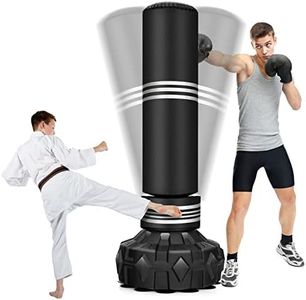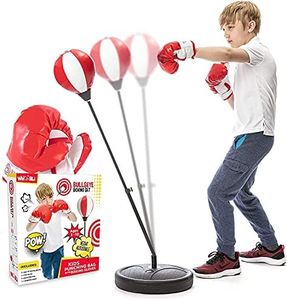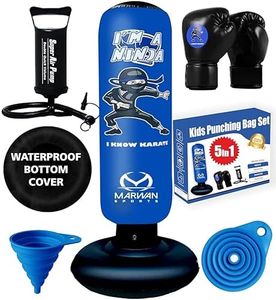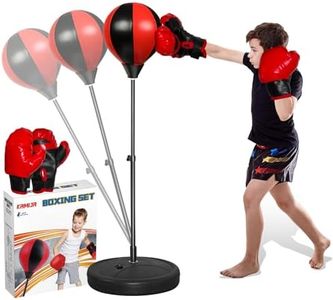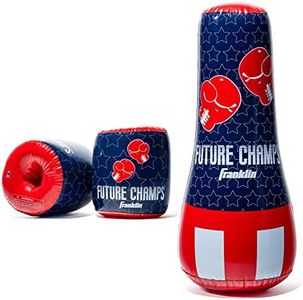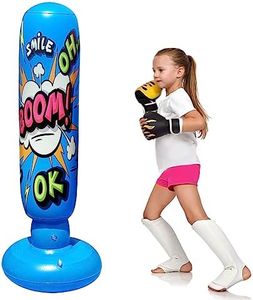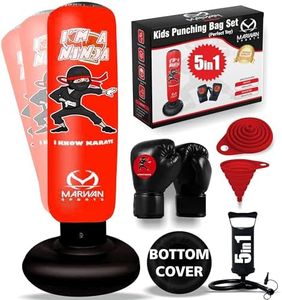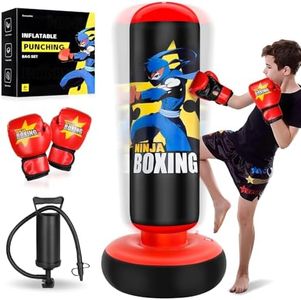We Use CookiesWe use cookies to enhance the security, performance,
functionality and for analytical and promotional activities. By continuing to browse this site you
are agreeing to our privacy policy
10 Best Kids Punching Bags
From leading brands and best sellers available on the web.Buying Guide for the Best Kids Punching Bags
When choosing a kids' punching bag, it's important to focus on safety, age appropriateness, and how the bag matches your child’s intended use. Punching bags for kids are designed to help with fitness, coordination, and stress release while also being fun. Your goal should be to find a bag that is durable, safe, and fits well in your available space, while also being engaging and motivating for your child to use.Age RecommendationThe age recommendation tells you which age group the punching bag is best suited for. This matters because bags for younger kids are lighter, softer, and designed to be safer, while bags for older children can be heavier and more challenging. When checking these ages, make sure your child's age falls within the manufacturer’s suggested range to maximize both fun and safety.
Height and SizeThe height and size of the punching bag determine how comfortable it will be for your child to use. Smaller, shorter bags are easier for young kids to punch and kick, while taller or heavier bags suit older children or those who want a more realistic training experience. For picking the right size, think about your child's height; a good rule is to pick a bag that stands about chest-to-shoulder height for your child so they can punch it without overreaching.
Weight and Fill MaterialPunching bags can be filled with air, foam, or sometimes sand and water, and this fill affects how hard the bag is and how much it swings or moves. Lightweight inflatable bags are best for small children or those who will use the bag for play, while heavier fill works better for older or more active kids who want to practice technique. Match the weight to the strength and enthusiasm of your child—inflatable is great for beginners and soft play, while sand or water fill is better for those looking for a sturdier, more stable target.
Type (Freestanding vs. Hanging)There are two main kinds: freestanding bags and hanging bags. Freestanding punching bags sit on the floor and are simple to move and set up—these are best for younger kids or those without a permanent place to hang a bag. Hanging bags need to be attached to a strong support and often offer a more realistic boxing feel, better for older kids and those with more permanent play areas. Choose freestanding for flexibility and easy storage, or hanging for a more authentic experience if space allows.
Durability and MaterialThe material of a kids' punching bag impacts how long it lasts, and how safe it is to hit. Look for bags with soft outer coverings like vinyl or fabric that can handle frequent punches but aren't too rough on little hands. Higher quality materials mean better durability and less chance of tearing or leaking. If your child will use the bag often, choose a model known for strong stitching and sturdy material.
Safety FeaturesSafety features include things like rounded edges, secure bases, and stable construction to prevent tipping over. Some bags come with a weighted base or suction cups to keep them in place. For small children especially, these safety elements are important to prevent accidents. Think about your child’s play habits—if they're likely to get rowdy, prioritize a punching bag that stays put and has extra safety precautions.
Assembly and StorageEase of assembly means how simple it is to set up or take down the punching bag. Inflatable bags are quick to set up and can be deflated for storage, while heavier filled or hanging bags may take more time and require specific tools or mounts. If you want something you can easily put away when not in use, look for a lightweight or inflatable option. For a permanent solution, a well-mounted hanging bag could be better.

